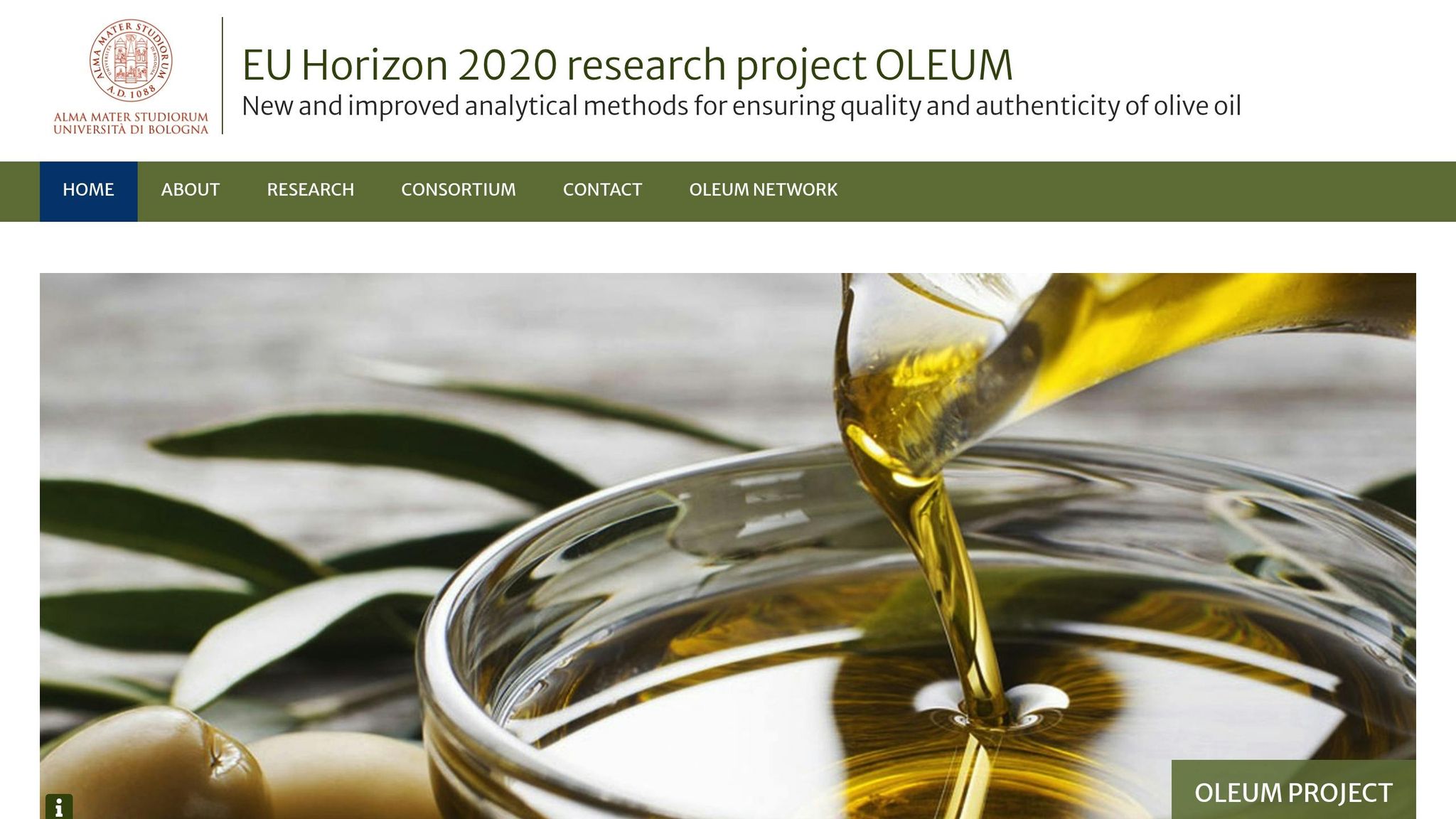Volatile Compounds in Olive Oil: Analysis Methods
Volatile compounds determine olive oil's flavor, aroma, and quality. Key compounds like E-2-hexenal, hexanal, and 1-penten-3-one indicate freshness or flaws like rancidity. Advanced methods like SPME-GC-FID and SPME-GC-MS analyze these markers to ensure quality, detect defects, and confirm authenticity. Factors like olive variety, harvest timing, and storage conditions also impact these compounds. Producers follow strict International Olive Council (IOC) standards to meet extra virgin olive oil (EVOO) criteria, ensuring consistent quality and freshness.
OLEUM: Method for the analysis of volatile compounds in virgin olive oil by SPME-GC-FID/MS

How Volatile Compounds Impact Olive Oil Quality
Volatile compounds play a pivotal role in shaping olive oil's flavor and determining if it meets the standards for extra virgin classification. These molecular markers are essential in assessing the oil's freshness and overall quality.
Taste and Smell Components
Certain compounds are directly responsible for the distinctive aromas and flavors found in high-quality olive oil. For example, E-2-hexenal contributes a fresh green apple and cut grass aroma, while 1-penten-3-one introduces pleasant fruity notes.
Here’s a closer look at some key markers:
| Volatile Compound | Sensory Attribute | Quality Indication |
|---|---|---|
| E-2-hexenal | Green apple, grass | Indicates freshness and proper handling |
| 1-penten-3-one | Fruity notes | Reflects desired quality traits |
| Hexanal (low levels) | Fresh, green notes | Falls within the normal quality spectrum |
When these compounds are present in the right balance, they signal a well-crafted, properly stored oil. However, deviations from these profiles can hint at underlying issues or degradation.
Signs of Oil Deterioration
The levels of volatile compounds can also expose signs of deterioration. As certain markers increase, they reveal potential quality problems.
Some key indicators of degradation include:
- Hexanal levels above 10–15 µg/kg: A clear sign of rancidity.
- Nonanal: Points to oxidative degradation.
- 2,4-decadienal: Associated with musty or winey-vinegary off-flavors.
In laboratory settings, experts have identified 29 compounds - such as octane, ethyl acetate, and ethanol - that signal a decline in quality. Tracking these markers helps pinpoint the factors affecting the oil's volatile profile and guides further quality assessments.
Methods to Analyze Volatile Compounds
Laboratories use various techniques to analyze volatile compounds in olive oil, aiming to assess its quality and authenticity. These analyses reveal the compounds that influence the oil's sensory and chemical characteristics.
Standard Testing Methods
The EU H2020 OLEUM project standardized the SPME-GC-FID method to accurately measure 18 volatile compounds linked to olive oil's quality and potential defects. This method combines Solid-Phase Microextraction (SPME) for sample preparation with Gas Chromatography-Flame Ionization Detection (GC-FID) for analysis. Here's how it works: gas chromatography separates the compounds, while the flame ionization detector identifies them by burning in a hydrogen flame.
| Testing Parameter | GC-FID Capability | Quality Indication |
|---|---|---|
| Compound Range | 18 key volatiles | Markers of quality and defect indicators |
| Detection Limit | Parts per billion | Detects early signs of quality issues |
While this traditional approach is reliable, modern advancements have expanded the scope of volatile compound analysis.
Modern Testing Equipment
SPME-GC-MS (Gas Chromatography-Mass Spectrometry) systems have taken volatile compound testing to the next level, identifying up to 29 compounds that shape olive oil's sensory profile. This advanced technology offers several key benefits:
- Precise Identification: Delivers structural details of unknown compounds.
- Improved Sensitivity: Detects even trace amounts of volatile compounds.
- Flexible Detection: Adapts to a wide range of analytical needs.
These methods have undergone international validation, confirming their effectiveness. While GC-FID is often favored for its reproducibility with certain compounds, GC-MS excels in detailed compound characterization, making it invaluable for more complex analyses.
Together, these techniques complement sensory evaluations by providing objective, data-driven insights. To ensure industry-wide consistency, the International Olive Council (IOC) has established official standards for determining volatile compounds (COI/T.20/Doc. No 37).
What Changes Volatile Compound Levels
From cultivation to storage, every step in olive oil production influences its volatile compounds, which are key to its flavor and quality.
Olive Type and Harvest Factors
The type of olive and the timing of its harvest play a huge role in shaping the oil's aroma and taste. Each variety brings its own genetic traits, creating a distinct profile. The concentration of important volatile compounds can shift dramatically depending on various factors:
| Factor | Impact on Volatile Compounds | Quality Indicators |
|---|---|---|
| Olive Variety | Determines enzyme activity and precursor compounds | Influences levels of hexanal, E-2-hexenal, and 1-penten-3-one |
| Climate | Warmer temperatures speed up ripening | Changes the balance of aroma compounds |
| Water Stress | Boosts certain aldehydes and alcohols | Enhances flavor intensity |
| Harvest Timing | Early harvest produces green, grassy notes; late harvest creates softer, sweeter profiles | E-2-hexenal peaks in early harvests |
For instance, olives harvested early often yield oils rich in compounds like E-2-hexenal and hexanal, resulting in fresh, grassy aromas. On the other hand, later harvests lead to oils with softer flavors, featuring more ethanol and ethyl acetate.
The journey doesn't stop at the harvest. What happens after - during processing and storage - also plays a big part in shaping the oil's volatile profile.
Production and Storage Effects
How olive oil is extracted and stored can either preserve or degrade its volatile compounds. Careful management of these processes is essential to maintaining its sensory qualities.
Key storage factors include:
- Temperature: Keeping oil cool slows down degradation.
- Light Exposure: Using dark containers minimizes harmful photochemical reactions.
- Oxygen Contact: Airtight packaging helps prevent oxidation.
- Storage Duration: Over time, volatile compounds naturally break down.
Producers work hard to protect the oil's quality by using rapid processing, precise extraction techniques, and optimal storage conditions. These efforts help maintain the delicate balance of volatiles, ensuring the oil retains its authentic flavor and aroma.
sbb-itb-4066b8e
Quality Testing Applications
To ensure that production processes meet the high standards of premium extra virgin olive oil (EVOO), thorough quality testing plays a pivotal role. One key aspect of this testing is analyzing volatile compounds, which helps confirm both the quality and authenticity of the oil. Modern testing techniques can pinpoint positive sensory traits while identifying any potential flaws, guaranteeing that consumers receive genuine EVOO.
Testing Standards
The International Olive Council (IOC) has set strict guidelines for analyzing volatile compounds in olive oil, ensuring consistent quality and authenticity. Here's a breakdown of key volatile markers and their significance:
| Quality Indicator | Key Volatile Compounds | Significance |
|---|---|---|
| Positive Attributes | Hexanal, E-2-hexenal, 1-penten-3-one | Indicate fresh, fruity, and green characteristics |
| Defect Markers | Octane, ethyl acetate, pentanal | Reveal rancidity or fermentation issues |
| Authenticity Verification | 18 standardized compounds | Confirms the oil's genuine EVOO status |
The harmonized SPME-GC method, validated internationally across 20 laboratories, has become a cornerstone in verifying EVOO authenticity. Efforts like the EU OLEUM project have further refined these protocols, standardizing processes such as sample preparation, calibration, and analysis. This reduces variability between laboratories and ensures consistent, reliable results worldwide.
These standardized approaches form the foundation for advanced testing methods used by top-tier producers.
Big Horn Olive Oil's Quality Methods

Big Horn Olive Oil takes quality assurance to the next level by integrating the established SPME-GC testing with advanced HS-SPME-GC-MS technology. This enhanced testing method allows the company to:
- Detect both desirable attributes and potential defects
- Verify the oil's freshness and authenticity
- Confirm proper storage conditions
- Identify quality concerns early on
Big Horn Olive Oil’s dedication to quality is evident in its adherence to international testing standards. Every batch undergoes meticulous analysis to ensure it meets premium EVOO criteria, focusing on volatile compound profiles that highlight fresh, fruity notes while eliminating any signs of defects.
This rigorous testing also guarantees a high smoke point (above 410°F) and preserves the oil’s natural antioxidants. By maintaining strict oversight of volatile compounds, Big Horn Olive Oil ensures its products consistently deliver the hallmark freshness and flavor of top-quality EVOO.
Summary
Analyzing volatile compounds plays a crucial role in modern olive oil quality checks, offering an objective layer to support traditional sensory evaluations. The internationally validated SPME-GC testing method has become a trusted tool for assessing oil quality and authenticity.
Volatile compounds like hexanal and octane are key markers that serve two purposes: they highlight positive attributes while also signaling potential defects. These compounds help create unique profiles that reveal both the oil's quality and any early signs of deterioration.
Such detailed testing underpins rigorous quality control processes. At Big Horn Olive Oil, these advanced methods ensure the freshness of their products, allow for early detection of defects, and uphold their commitment to producing extra virgin olive oil (EVOO) with high smoke points exceeding 410°F.
The EU H2020 OLEUM project has further contributed by establishing reliable protocols that ensure consistent quality assessments across the globe. This standardization empowers top-tier producers to confirm product authenticity while maintaining excellence.
| Quality Aspect | Testing Impact | Consumer Benefit |
|---|---|---|
| Freshness Verification | Measures positive volatile markers | Delivers peak flavor and aroma |
| Defect Detection | Identifies negative compounds early | Ensures a consistent experience |
| Authenticity Confirmation | Verifies genuine EVOO status | Protects against adulteration |
FAQs
How do volatile compounds like E-2-hexenal and hexanal influence the flavor and quality of olive oil?
Volatile compounds like E-2-hexenal and hexanal are key players in defining the flavor, aroma, and overall quality of olive oil. These compounds give high-quality olive oil its signature profile - E-2-hexenal brings a fresh, green aroma, while hexanal adds subtle nutty or herbal undertones.
The balance of these compounds is also crucial for quality control and authenticity testing. Any imbalance or the presence of off-flavors can signal issues like oxidation, improper storage, or subpar production methods. By understanding and managing these elements, producers such as Big Horn Olive Oil create Ultra Premium Extra Virgin Olive Oils that not only taste exceptional but also offer notable health benefits.
What is the difference between SPME-GC-FID and SPME-GC-MS in analyzing volatile compounds in olive oil?
SPME-GC-FID and SPME-GC-MS: Analyzing Volatile Compounds in Olive Oil
SPME-GC-FID (Solid-Phase Microextraction Gas Chromatography with Flame Ionization Detection) and SPME-GC-MS (Solid-Phase Microextraction Gas Chromatography with Mass Spectrometry) are two powerful tools for examining the volatile compounds in olive oil. While both are highly effective, they serve slightly different purposes.
SPME-GC-FID focuses on quantifying volatile compounds. It excels at measuring their concentrations with great precision. However, it doesn't provide much detail about the molecular structure of these compounds.
In contrast, SPME-GC-MS goes a step further. Not only does it quantify the compounds, but it also identifies their exact chemical composition. This makes it perfect for in-depth profiling and ensuring the authenticity of olive oil.
Together, these techniques ensure top-notch quality and authenticity, enabling producers like Big Horn Olive Oil to maintain high standards in their products.
How do olive variety and harvest timing affect the levels of volatile compounds in olive oil?
The type of olives used and the timing of their harvest have a big impact on the volatile compounds found in olive oil. These compounds are what give the oil its distinctive aroma and flavor - key markers of its quality and authenticity.
Each olive variety naturally brings its own unique profile of volatile compounds, resulting in oils with distinct sensory traits. Harvest timing also plays a crucial role. Olives picked early in the season tend to produce oils with bold, fruity, and grassy flavors, thanks to higher concentrations of specific volatiles. In contrast, oils made from late-harvest olives often have a milder, more subdued taste.
Recognizing these elements is crucial for creating exceptional olive oils, like the Ultra Premium Extra Virgin Olive Oils from Big Horn Olive Oil, which focus on delivering freshness, robust flavor, and genuine quality.

